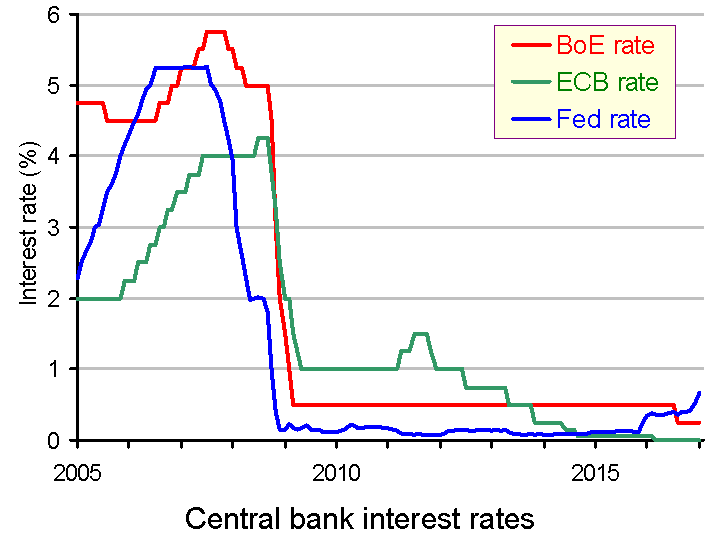 Interest rates have been at record lows across the developed world since 2009. Interest rates were reduced to such levels in order to stimulate recovery from the financial crisis of 2007–8 and the resulting recession. The low interest rates were accompanied by extraordinary increases in money supply under various rounds of quantitative easing in the USA, UK, Japan and eventually the eurozone. But have such policies done harm?
Interest rates have been at record lows across the developed world since 2009. Interest rates were reduced to such levels in order to stimulate recovery from the financial crisis of 2007–8 and the resulting recession. The low interest rates were accompanied by extraordinary increases in money supply under various rounds of quantitative easing in the USA, UK, Japan and eventually the eurozone. But have such policies done harm?
This is the contention of Brian Sturgess in a new paper, published by the Centre for Policy Studies. He maintains that the policy has had a number of adverse effects:
| • | There will be nothing left in the monetary policy armoury when the next downturn occurs other than even more QE, which will compound the following problems. |
| • | It has had little effect in stimulating aggregate demand and economic growth. Instead the extra money has been used to repair balance sheets and support unprofitable businesses. |
| • | It has inflated asset prices, especially shares and property, which has encouraged funds to flow to the secondary market rather than to funding new investment. |
| • | The inflation of asset prices has benefited the already wealthy. |
| • | By keeping interest rates down to virtually zero on savings accounts, it has punished small savers. |
| • | By rewarding the rich and penalising small savers, it has contributed to greater inequality. |
| • | By keeping interest rates down to borrowers, it has encouraged households to take on excessive amounts of debt, which will be hard to service if interest rates rise. |
| • | It has lowered the price of risk, thereby encouraging more risky types of investment and the general misallocation of capital. |
 Sturgess argues that it is time to end the policy of low interest rates. Currently, in all the major developed economies, central bank rates are below the rate of inflation, making the real central bank interest rates negative.
Sturgess argues that it is time to end the policy of low interest rates. Currently, in all the major developed economies, central bank rates are below the rate of inflation, making the real central bank interest rates negative.
He welcomes the two small increases by the Federal Reserve, but this should be followed by further rises, not just by the Fed, but by other central banks too. As Sturgess states in the paper (p.12):
In place of ever more extreme descents into the unknown, central banks should quickly renormalise monetary policy. That would involve ending QE and allowing interest rates to rise steadily so that interest rates can carry out their proper functions. Failure to do so will leave the global financial system vulnerable to potential shocks such as the failure of the euro, or the fiscal stresses in the US resulting from the unfinanced spending plans announced by Donald Trump in his presidential campaign.
Although Sturgess argues that the initial programmes of low interest rates and QE were a useful response to the financial crisis, he argues that they should have only been used as a short-term measure. However, if they were, and if interest rates had gone up within a few months, many argue that the global economy would rapidly have sunk back into recession. This has certainly been the position of central banks. Sturgess disagrees.
Articles
Damaging low interest rates and QE must end now, think thank warns The Telegraph, Julia Bradshaw (23/1/17)
QE has driven pension deficits up, think-tank argues Money Marketing, Justin Cash (23/1/17)
Hold: The ECB keeps interest rates and QE purchases steady as Mario Draghi defends loose policy from hawkish critics City A.M., Jasper Jolly (19/1/17)
Preparing for the Post-QE World Bloomberg, Jean-Michel Paul (12/10/16)
Paper
Stop Depending on the Kindness of Strangers: Low interest rates and the Global Economy Centre for Policy Studies, Brian Sturgess (23/1/17)
Questions
- Find out what the various rounds of quantitative easing have been in the USA, the UK, Japan and the eurozone.
- What are the arguments in favour of quantitative easing as it has been practised?
- How might interest rates close to zero result in the misallocation of capital?
- Sturgess claims that the existence of ‘spillover’ effects has had damaging effects on many emerging economies. What are these spillover effects and what damage have they done to such economies?
- How do low interest rates affect interest rate spreads?
- Have pensioners gained or lost from QE? Explain how the answer may vary between different pensioners.
- What is meant by a ‘natural’ or ‘neutral’ rate of interest (see section 3.2 in the paper)? Why, according to Janet Yellen (currently Federal Reserve Chair, writing in 2005), is this somewhere between 3.5% and 5.5% (in nominal terms)?
- What are the arguments for and against using created money to finance programmes of government infrastructure investment?
- Would helicopter money be more effective than QE via asset purchases in achieving faster economic growth? (See the blog posts: A flawed model of monetary policy and New UK monetary policy measures – somewhat short of the kitchen sink.)
- When QE comes to an end in various countries, what are the arguments for absorbing rather than selling the assets purchased by central banks? (See the Bloomberg article.)